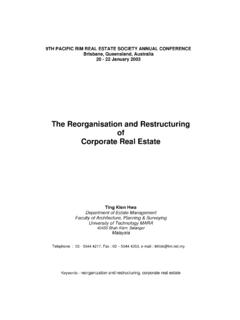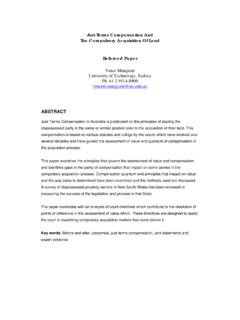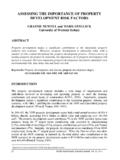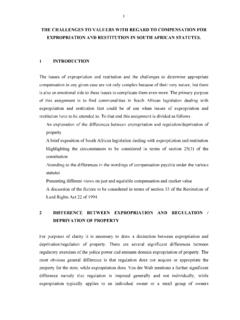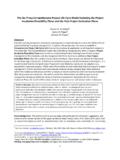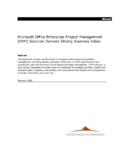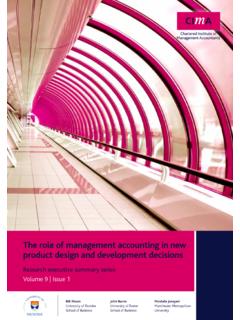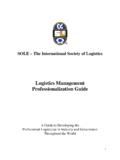Transcription of Identifying Key Risks in Construction Projects: Life Cycle ...
1 1 Identifying Key Risks in Construction Projects: life Cycle and Stakeholder Perspectives Dr Patrick. Zou1, Dr Guomin Zhang2 and Professor Jia-Yuan Wang3 1 and 2: Faculty of Built Environment, University of New South Wales, Sydney 2052, Australia; 3: College of Architecture and Civil Engineering, Shenzhen University, Shenzhen, China E-mail addresses: Abstract Managing Risks in Construction projects has been recognised as a very important management process in order to achieve the project objectives in terms of time, cost, quality, safety and environmental sustainability.
2 However, until now most research has focused on some aspects of Construction risk management rather than using a systematic and holistic approach to identify Risks and analyse the likelihood of occurrence and impacts of these Risks . This paper aims to identify and analyse the Risks associated with the development of Construction projects from project stakeholder and life Cycle perspectives. Postal questionnaire surveys were used to collect data. Based on a comprehensive assessment of the likelihood of occurrence and their impacts on the project objectives, this paper identifies twenty major risk factors.
3 This research found that these Risks are mainly related to (in ranking) contractors, clients and designers, with few related to government bodies, subcontractors/suppliers and external issues. Among them, tight project schedule is recognised to influence all project objectives maximally, whereas design variations , excessive approval procedures in administrative government departments , high performance/quality expectation , unsuitable Construction program planning , as well as variations of Construction program are deemed to impact at least four aspects of project objectives.
4 This research also found that these Risks spread through the whole project life Cycle and many Risks occur at more than one phase, with the Construction stage as the most risky phase, followed by the feasibility stage. It is concluded that clients, designers and government bodies must work cooperatively from the feasibility phase onwards to address potential Risks in time, and contractors and subcontractors with robust Construction and management knowledge must be employed early to make sound preparation for carrying out safe, efficient and quality Construction activities.
5 Keywords: risk, risk management, Construction projects, life Cycle , stakeholders perspectives Introduction Risk management may be described as a systematic way of looking at areas of risk and consciously determining how each should be treated. It is a management tool that aims at Identifying sources of risk and uncertainty, determining their impact, and developing appropriate management responses (Uher, 2003). A systematic process of risk management has been divided into risk classification, risk identification, risk analysis and risk response, where risk response has been further divided into four actions, retention, reduction, transfer and avoidance (Berkeley et al.)
6 , 1991; Flanagan and Norman, 1993). An effective risk management method can help to understand not only what kinds of Risks are faced, but also how to manage these Risks in different phases of a project. Owing to its increasing importance, 2 risk management has been recognized as a necessity in most industries today, and a set of techniques have been developed to control the influences brought by potential Risks (Schuyler, 2001; Baker and Reid, 2005). Compared with many other industries, the Construction industry is subject to more Risks due to the unique features of Construction activities, such as long period, complicated processes, abominable environment, financial intensity and dynamic organization structures (Flanagan and Norman, 1993; Akintoye and MacLeod, 1997; Smith, 2003).
7 Hence, taking effective risk management techniques to manage Risks associated with variable Construction activities has never been more important for the successful delivery of a project. Previous research has mainly focused on examining the impacts of Risks on one aspect of project strategies with respect to cost (Chen et al., 2000), time (Shen, 1997) and safety (Tam et al., 2004). Some researchers investigated risk management for Construction projects in the context of a particular project phase, such as conceptual/feasibility phase (Uher and Toakley, 1999), design phase (Chapman, 2001), Construction phase (Abdou, 1996), rather than from the perspective of a project life Cycle .
8 Moreover, little research has probed Risks from the perspectives of project stakeholders. As part of a much larger project aiming to articulate and manage key Risks associated with Construction projects, this paper presents the results of a questionnaire survey and seeks to identify the potential key Risks from the perspectives of stakeholders and project life Cycle . Related Past Research and Risk Classification Substantive research has been done in the field of risk management for Construction projects, a significant outcome of which is the identification of many Risks that may influence the Construction project delivery.
9 Chen et al. (2004) proposed 15 Risks concerned with project cost and divided them into three groups: resources factors, management factors and parent factors. Through a case study on the West Rail Project of Hong Kong, Chen found that price escalation of material pertaining to resource factors, inaccurate cost budget and supplier or subcontractors default pertaining to management factors, and excessive interface on project management pertaining to parent factors are the most significant Risks in this particular project.
10 Summarizing other researchers work, Shen (1997) identified eight major Risks accounting for project delay and ranked them based on a questionnaire survey with industry practitioners. Shen also proposed risk management actions to cope with these Risks and validated their effectiveness through individual interview surveys. Tam et al. (2004) conducted a survey to examine the elements of poor Construction safety management in China and as a result, identified the main factors affecting safety performance including poor safety awareness of top management , lack of training , poor safety awareness of project managers , reluctance to input resources to safety and reckless operation.
